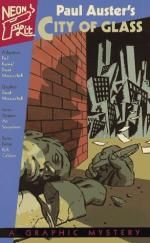|
This section contains 1,312 words (approx. 5 pages at 300 words per page) |

|
SOURCE: “This Dog's Life,” in New York Times Book Review, June 20, 1999, p. 11.
In the following review, Shepard offers positive assessment of Timbuktu, though finds fault in lapses of self-consciousness and overstatement in the novel.
At least since Alexander Pope, literature has been drafting dogs into service as metaphysical guides: “I am his Highness' Dog at Kew; / Pray tell me Sir, whose Dog are you?” The protagonist of Paul Auster's latest novel, Timbuktu, may be a “hodgepodge of genetic strains” who's all burrs and bad smells, with a “perpetual bloodshot sadness lurking in his eyes,” but he carries on that tradition. Unable to speak (though he can passably render the anapest of his three-syllable name: “woof woof woof”). Mr. Bones opens the novel in a state of near-pure ontological terror, mostly because Willy G. Christmas, the homeless man who has been his boon companion and spiritual adviser, isn't long...
|
This section contains 1,312 words (approx. 5 pages at 300 words per page) |

|


